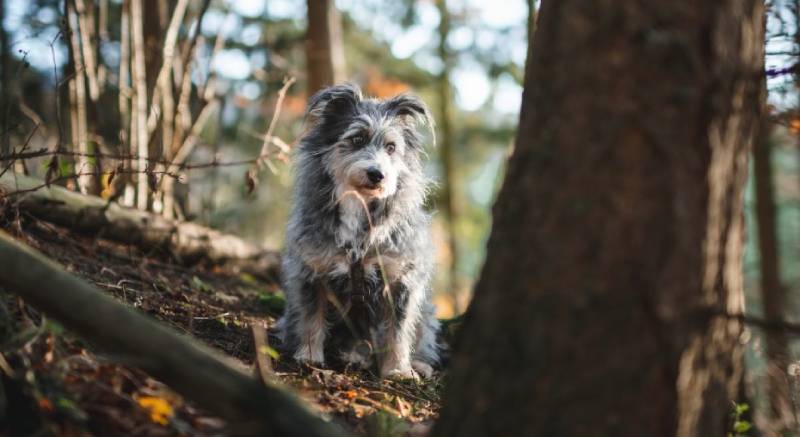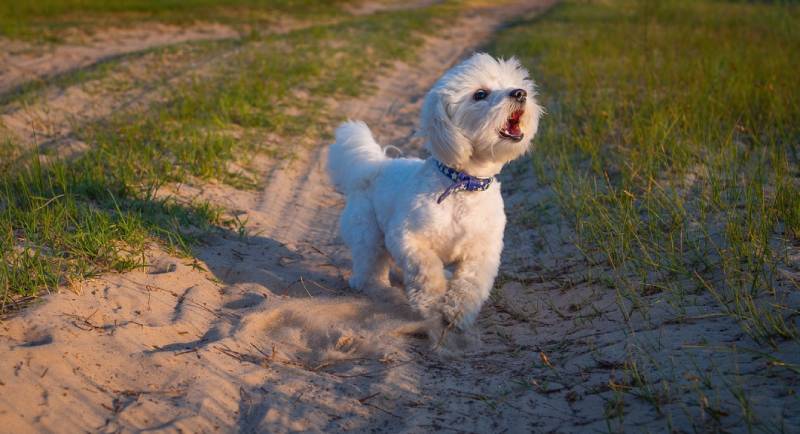Imagine this: A dingo-mix named Valerie survived for 16 months in the rugged Australian wilderness before being safely recovered. Her story, reported by National Geographic, has left many pet owners wondering — can dogs live in the wild?
Whether due to abandonment or a pet going missing, it’s a question that weighs heavily on the hearts of dog lovers. While dogs do have ancestral roots in the wild, thousands of years of domestication have fundamentally reshaped them. Today’s domestic dog is far removed from its wolf-like ancestors — but some primal instincts still remain.
Well, the truth is even more complex. In this post, we’ll explore whether dogs can truly survive in the wild, how breed and environment matter, and what it means for pet owners facing a lost or stray dog situation.

Domestic Dogs vs. Wild Ancestors
Dogs and wolves may share a common ancestor, but they’ve been walking very different evolutionary paths for tens of thousands of years. Modern dogs (Canis familiaris) began their domestication journey somewhere between 20,000 and 40,000 years ago. Over generations, selective breeding has emphasized traits that make dogs better companions for humans — friendliness, trainability, dependence, and even physical features that are far from the rugged durability of wild canines.
Still, echoes of their wild past remain.
Dogs may no longer need to hunt to survive, but many still display basic instincts rooted in their wolf ancestry. Domestic dogs often exhibit behaviors like chasing bugs, digging, sniffing out rodents, marking territory, or burying food — survival strategies once critical in the wild.
Survival Skills & Limitations: Breeds and Biology
Not all dogs are built the same — and when it comes to survival in the wild, breed matters. While some dogs are naturally better equipped for harsh outdoor conditions, others would struggle within hours.
Hardy Breeds: Built for the Wild
Certain breeds retain physical traits and instincts that give them a better shot at survival in the wild. Take the Siberian Husky, for example. With their thick double coat, endurance, and high prey drive, huskies and similar working breeds (like Malamutes, German Shepherds, or Akitas) can fare much better in outdoor environments. These dogs often have the stamina, alertness, and resilience inherited from their wolf ancestors.
Vulnerable Breeds: Poorly Suited for Survival
On the flip side, brachycephalic dogs — those with short snouts like Pugs, Bulldogs, and Shih Tzus — often struggle in wild conditions. Their compact nasal passages can lead to respiratory issues, especially in heat or during exertion. These dogs overheat easily and tire quickly, making survival extremely difficult.
Small toy breeds like Chihuahuas, Pomeranians, or Yorkies face their own set of problems: vulnerability to predators, exposure to cold, and an inability to forage or travel long distances.

Size, Health, and the Energy Equation
Very small dogs may be easy prey for larger animals and are more sensitive to temperature extremes. Very large dogs, on the other hand, require more calories — a challenge in the wild where food is scarce. Mid-sized working dogs often strike the best balance between agility, strength, and endurance.
Health is also a key factor. Dogs with chronic illnesses, arthritis, or previous injuries are far less likely to survive without human care.
Pack Behavior: Survival in Numbers
Dogs that live in the wild or on the streets — often referred to as feral or stray dogs — tend to form packs, sometimes with 10 or more members. This pack behavior increases their chances of survival. In groups, dogs can cooperate to find food, protect one another from predators, and maintain territory.
Stray dogs often survive by scavenging garbage, hunting rodents, or relying on human scraps. But their lives are far from easy. Most street dogs face shorter lifespans, higher risks of disease, and frequent injuries — a stark contrast to the comfort and care they would receive in a home.
Stray and Feral Dogs: Life in the Wild or Urban Jungle
While it may be hard to imagine for those who live with pampered pups, millions of dogs around the world survive without any human care. According to the World Health Organization, an estimated 200 million stray dogs roam freely across cities, villages, and wilderness. These are not just lost pets — many are born on the streets and become part of a global population of free-ranging or feral dogs.
Feral and stray dogs survive largely through scavenging and adaptation. In urban environments, they find food in garbage bins, handouts from sympathetic locals, and scraps left around outdoor eateries. They seek warmth in building crevices, under vehicles, or near generator exhausts. In rural or wild areas, survival depends more on hunting small prey like rodents, birds, or even insects.
Often, these dogs form packs to improve their odds — cooperating for protection, warmth, and food. Packs of 10 or more are not uncommon, especially in densely populated or resource-rich regions..
Lost Dogs & “Survival Mode” (Lost Dog Syndrome)
When a beloved pet goes missing, many owners expect their dog to come running when called. But what often happens is more confusing — the dog hides, avoids people, or even runs from its owner. Why?
Many lost dogs enter a state called “survival mode” — also known as lost dog syndrome. In this heightened state of stress, the dog’s brain essentially flips into a feral mindset, where the only focus is survival: finding food, water, and shelter, and avoiding all perceived threats — even familiar people.
What Pet Owners Can Do: Recovery & Prevention
Even though dogs have some survival instincts, they are not equipped to live safely or happily without humans. As a pet owner, you play a crucial role in both recovery and prevention when it comes to lost dogs and strays.
How to Find a Lost Dog: Quick Action Saves Lives
According to experts, most lost dogs don’t travel far — especially in the first 24 hours. Acting quickly increases the odds of a safe reunion.
Step-by-step recovery tips:
Microchips & ID Tags: Small Tools, Big Impact
Don’t underestimate the power of proper identification. Dogs with microchips are more than twice as likely to be reunited with their owners, and ID tags help strangers assist your pet in seconds.
Even though some dogs can survive in the wild for a time, experts agree: dogs are not well-equipped to handle the dangers of outdoor life long-term.
Conclusion
Can dogs live in the wild? While dogs share ancestry with wolves, thousands of years of domestication have transformed them into animals that depend on humans for survival. Some dogs — especially working or primitive breeds — may survive short-term in the wild by relying on instincts like scavenging or forming packs. However, the harsh realities of disease, hunger, predators, and climate mean that most lost or abandoned dogs struggle to survive, let alone thrive.
Whether you’re worried about a lost pet or wondering how stray dogs live, the truth is clear: dogs belong in loving homes, not fending for themselves in the wild.
FAQ
Can a dog really survive alone in the wild?
Some dogs can survive short-term thanks to instincts like foraging and pack behavior. However, most domesticated dogs cannot thrive long-term without humans due to risks like starvation, disease, injury, and extreme weather.
Are some dog breeds better at surviving in nature?
Yes. Working and primitive breeds like huskies or shepherds, with thick coats and strong prey drive, adapt more easily. In contrast, toy breeds and brachycephalic dogs (like pugs and bulldogs) struggle with temperature regulation and physical stress.
How long can a lost dog survive without food or water?
Generally, a healthy dog might survive up to 3 days without water and several weeks without food, but survival depends on age, breed, weather, and terrain. Immediate recovery efforts are crucial.


